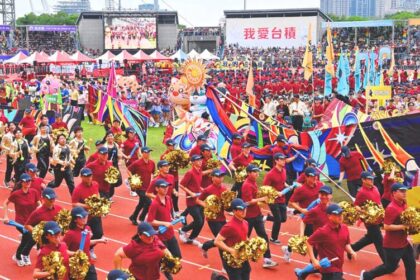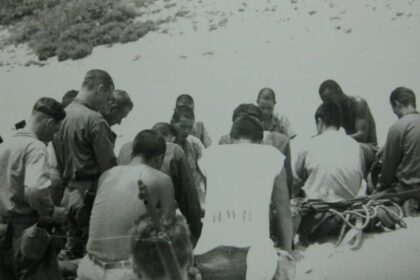A curious lift into the hills
On a quiet stretch of the Yatsugatake foothills in Hokuto City, Yamanashi, a roadside station hides a small piece of mountain transit theater. Behind Michi no Eki Minami Kiyosato, a narrow rail disappears into trees, climbing so steeply that the endpoint is out of sight. Buy a ticket for 500 yen and a sky blue car glides down to meet you. It is driverless, compact, and marked Koinobori Village, a nod to the local spring tradition of colorful carp streamers. Step inside and you rise swiftly through cedar and larch, the ground dropping away under the car’s glass. In about three and a half minutes, the vehicle delivers you to a hilltop garden with big views and space to wander. The ride is short, but it turns a routine rest stop into a small adventure.
Japan’s Michi no Eki network was designed to make road travel easier and to connect visitors with local communities. These stations offer free parking, clean restrooms that stay open around the clock, local produce markets, small eateries, tourist information, and usually a few surprises that reflect the region. There are more than a thousand across the country, and each leans into local character. Some feature farm stands or craft shops. Others function as event spaces or trailheads. Minami Kiyosato checks the usual boxes, then adds something rare, a mountain lift that turns a roadside pause into a destination. For drivers exploring the uplands between Kofu and Nagano, it is an easy detour that rewards curiosity.
What is a slope car and how does it work
The vehicle operating here looks like a monorail, and it climbs like a funicular, yet it is a different machine. Known in Japan as a slope car, it uses an electric motor that drives a pinion gear along a fixed rack laid on the guideway. The system at Minami Kiyosato was built around 2000 by Kaho Monorail, a manufacturer that specializes in compact hillside transports for parks and resorts. The car runs automatically without a driver and is supervised from the station. Under Japan’s Building Standards Act, this type of installation is classified as an elevator, not as a railway under the Railway Business Act. That designation reflects its short route and dedicated right of way. The car fits about 20 passengers, and the floor is level for easy boarding. Wheelchair users can roll in and out without ramps, which makes it a practical way to reach the hilltop garden.
The line connects two tiny platforms named Magoi at the roadside station and Higoi at the summit. The numbers tell the story. The track is about 180 meters long, the vertical difference between the stations is about 100 meters, and the steepest section tilts to roughly 40 degrees. The ride lasts around three and a half minutes. On the way up, tree trunks frame small windows of farmland and distant peaks. On the way down, the slope drops away so quickly that it can feel like the approach to a ski jump. The car’s speed is modest, yet the combination of grade and perspective heightens the sensation. The guideway is set amid forest, which keeps the experience cool and quiet in summer.
From roadside station to Flower Forest Park
Boarding at the station is straightforward. The small platform is signed for the Lift Car, and an attendant takes tickets before the next run. The bodywork is painted light blue and labeled Koinobori Village. That theme ties the ride to a local festival held each spring when more than 450 carp streamers, known as koinobori, are displayed to mark Children’s Day (May 5). The bright fish windsocks flutter above fields and streams around Hokuto, and some decorations appear on the car itself. As the vehicle climbs, you spot hints of the upper station through gaps in the branches. Higoi Station sits just below the Minami Yatsugatake Flower Forest Park, the goal at the top.
For those who prefer to walk, a footpath reaches the park in roughly twenty minutes from the roadside station. Many visitors opt for the car ride on the way up, then stroll down at an unhurried pace. Families with strollers or visitors using wheelchairs find the lift the easier choice in both directions. Views change with the seasons. Spring brings cool air and fresh greens. Summer is pleasant in the highland climate. Autumn turns the canopy vivid, and the steep grade makes the descent feel like a short roller coaster through gold and red leaves.
What awaits at the Flower Forest Park
The Flower Forest Park at the summit spreads across gentle slopes with beds of seasonal blooms and small ponds where carp and ducks circle in calm water. Wide open spaces give children room to run. A wooden lookout deck crowns a knoll near the top. The deck holds a small Bell of Hope. Local custom says wishes are granted if you ring it five times. From the deck, you can see across the farm country of northern Yamanashi. On clear days, the ridge line of the Yatsugatake range stands sharp on the horizon. Benches, shaded corners, and simple trails make it easy to linger.
A shop near the lookout serves casual food and sweets. The menu often includes pizza baked in a stone oven and honey soft serve ice cream made with local ingredients. Seasonal pastimes add a hands on element. At the right time of year, visitors can dig for sweet potatoes or try pressed flower crafts. A small store sells dried flower arrangements and souvenirs that reflect the setting. The combination makes the hilltop feel like a small park rather than a simple viewpoint.
When to visit and seasonal operations
Michi no Eki Minami Kiyosato typically opens daily from 8:30 a.m. to 5:00 p.m. The Flower Forest Park and lift operate from about 10:00 a.m. to 5:00 p.m., and the park closes during winter (December to March). A ticket for the lift costs 500 yen per person. Hours and prices can change with weather and season, so a quick check on the day of travel is wise. The lift is especially appealing in spring when the koinobori displays appear around the area and in late October and November when autumn colors peak. Summer afternoons are another good bet, since the highland air stays comfortable even when the Kofu Basin is hot.
Getting there and nearby attractions
The roadside station sits at 760 Nagasawa, Takanecho, Hokuto City, Yamanashi Prefecture. Drivers will find the lift platform behind the main building. Look for the simple rail pointing into the trees. Michi no Eki facilities typically include free parking and open restrooms, which makes Minami Kiyosato a convenient break on drives between Kofu and Chino or Suwa. Renting a car is straightforward for visitors who hold an International Driving Permit, and the surrounding network of country roads rewards slow travel with farm views and mountain backdrops.
If you want to extend the day, the Kiyosato area has more lift rides with grand scenery. Sun Meadows Kiyosato Highland Park runs a chairlift to a terrace with views of the Yatsugatake range and, on clear days, Mount Fuji. Families come for gravity carts, gentle walking routes, and a cafeteria with both Japanese and Western choices. The resort’s winter operations focus on skiing with firm groomed runs, and facilities are set up with accessible restrooms and seating, which helps visitors who use wheelchairs. In summer and early autumn, the terrace and go kart track are a relaxed complement to the quieter charm of the Flower Forest Park.
Yamanashi’s roadside stations often double as gateways to local experiences. South of Hokuto, Narusawa Michi no Eki serves as a meeting point for guided walks in the Aokigahara Jukai forest near Mount Fuji. That tour requires a booking and special gear, but it shows how these hubs connect travelers with nature and culture beyond the highways. Minami Kiyosato’s lift car follows the same spirit, giving access to hillside views and a compact garden that most drivers would otherwise miss.
Why roadside stations matter
Michi no Eki were introduced nationwide in the mid 1990s to support drivers and stimulate regional economies. The model is simple, combine essential services with a window into local life. By selling farm produce and crafts directly, hosting small performances or seasonal markets, and sharing travel information, these stations keep visitors in the area longer and spread spending into nearby towns. Many stations run stamp rallies that encourage people to visit multiple locations on a loop. The Minami Kiyosato lift car is a good example of how a small investment in quirky infrastructure can turn a rest stop into a highlight of a trip.
Tips for visitors
- Check the lift and park schedule and local weather on the day you travel.
- Bring small cash for tickets, snacks, and treats from the farm market.
- Give yourself 60 to 90 minutes for the ride and a relaxed stroll at the top.
- Hold the handrail during the descent, the grade is steep and the car can feel lively.
- Be considerate at the Bell of Hope. Take turns and do not block the deck.
- If you choose to walk one way, wear shoes with good grip for the hillside path.
- For wheelchairs and strollers, boarding is level and easy.
- Keep an eye on children near ponds and by platform edges.
- Arrive early on weekends and holidays to avoid lines.
Key Points
- A hidden slope car behind Michi no Eki Minami Kiyosato carries visitors up to the Minami Yatsugatake Flower Forest Park.
- The route is about 180 meters with roughly 100 meters of elevation gain and a maximum grade near 40 degrees. The ride takes about three and a half minutes.
- The driverless rack and pinion system was built around 2000 by Kaho Monorail and is classified as an elevator under Japanese law.
- Tickets cost 500 yen. The roadside station runs from 8:30 a.m. to 5:00 p.m. The hilltop park operates from about 10:00 a.m. to 5:00 p.m. and closes in winter (December to March).
- At the summit, expect gardens, views, a Bell of Hope, pizza baked in a stone oven, honey soft serve, pressed flower crafts, and seasonal potato digging.
- Spring features more than 450 carp streamers around the area, and autumn colors make the descent especially scenic.
- A footpath provides a 20 minute alternative to the ride, and the car is wheelchair accessible.
- Nearby Sun Meadows Kiyosato offers chairlifts, a mountain terrace, gravity carts, and accessible facilities, creating an easy add on for the same day.











